21 August, 2000
I got up early this morning excited to be going on the expedition. It seems
we have been spending a lot of our time waiting on transportation. And
even though I knew this was part of the conditions to traveling at the
poles, I was still chomping at the bit to be doing what we had planned. I
talked over with Dr. Radtke exactly what kind of data he wanted me to take
and how. It was agreed that I would take standard and total lengths of the
fish and then weigh them. Then I'd cut off their heads, with the viscera
attached and bag them with a card stating the date and length information.
We would dissect out the otoliths when we returned to the lab. I also took
a Global Postioning System (GPS) to record the latitude and longitude where
we took our samples. I packed all of the gear that I would need to do the
study, along with my personal gear for staying out for longer if necessary.
Anderson showed me how to use the satellite phone in case there would be an
emergency. It is able to beam up to a satelite from any unobstructed point
on the planet. I also grabbed a mess kit and enough food for 5 days.
By early afternoon I was ready. Mas Ole was performing kayak expertise for
two tourists ships that were in the harbor. It was said that they were the
only tourist ships that come to Qaanaaq in a year and they just happened to
come on the same day?! So the town was bustling with German and Danish
toursits mainly. I decided to take a short nap before setting off. I fell
asleep easily; I am getting quite used to falling asleep when it is not
dark.
It was late afternoon when we finally started out. The weather is cloudier
today, but I have dressed with my warmest clothing and feel quite prepared.
We traveled in the opposite direction, north, from the day we had gone to
Bowdoin Bay to narwhal hunt. The islands in the distance off to the west
were covered with ice that slowly cascaded down into the inlet. We passed
more closely to the eastern side; the shore rose steeply into burnt sawdust
colored cliffs with repeating erosional features called thaw slumps. As the
ocean waves erode underneath the cliffs, a landslide will pull down a
fraction of the cliff face creating a outcropped ridge at the top. Mas Ole
pointed over the din of the motor to a spectacular one of these and then
pointed to his eyebrow. As I gazed back at the cliff, I noticed that a
glacier was flowing just below it giving the illusion of the white of an eye
below the eyebrow. (See Pic of Qagdlussarssuaq, Greenlandic for "looks like
a large eyebrow".) It was a noisy but pleasant ride and after a time the
water and motor hypnotized me into another sleep.
We entered Mac Cormick Fjord (Iterdlagssuaq) after a few hours and slowed
the boat looking for a good place to set the gill net. We stopped at a
clear stream and filled up our water container and relieved ourselves. We
then went to the west end of the fjord to camp alongside the stream that
flowed from Lake Tassersuit. There were already five other Inuit groups
camping and fishing in the area. We set up our tent after scaling the small
rocky ridge with our gear. Mas Ole said he hadn't been here since he was
around 14, when he would summer here with his family. Mas Ole's tent low
tech tent was set up in less than fifteen minutes. Harpoons were stuck into
the ground for the posts and the canvas tent was drapped between them and
secured to the ground with the abundant rocks surrounding the site. He set
his primus stove going to warm the interior and we fixed a dinner of water
mixed with dehydrated vegetables tomato sauce and pasta. It tasted great
and with our bellys full we went to work to set our net. The floats at one
end of the net needed some repair and we were not sure if we would catch any
fish as there was a large gap.
We separated and I walked back along the ridge and toward the sound of the
river. Mas Ole went to anchor his boat. As I walked toward the river, I
gazed at the glaciers around me and could see in the distance those that fed
Lake Tassersuit. There was no vegetation rising above my calves, just the
predomiment orange, black, and green lichens covering the rocks, the white
tufts of cotton grass, and the "fall" colored foliage of the willow vines
below my steps. My ears perked up in the silence, but there was no sound
except for the rush of water. I kept moving toward the sound and came upon
a froth of grey milky glacier water tumbling over a rocky stream bed from
Lake Tassersuit. As I looked upstream I saw a fisherman, much like I would
have at home in Wisconsin, except he was fishing with a net that looked like
a lacrosse stick. I watched him for some time periodically scooping into
the water as he walked further away from me.
I returned to the tent just as Mas Ole was walking across the landscape from
the hunter's hut for this hunting area. We chatted as we prepared for
sleep. He told me his girlfriend's parents were fishing on the other side of
the stream; he had also arranged to buy fish from another fisherman, in case
we didn't get any ourselves. He said I didn't have to get up to check the
nets, as he would. I some how knew I would probably sleep through the night
as I cuddled up in my sleeping bag to drive out the increasing cold of
"night". I asked him how he knew when to sleep since it was either
continual light or continual darkness; he smiled when he looked at me and
said "I sleep when I am tired."
Before I feel asleep I told him that I would measure the fish in the morning
and that he should please leave that for me to do. Through the night I
would awake to find him gone checking the net; I don't think it was until 6
AM that he finally slept for more than a few hours. "We" caught nine char
in our nets that night.

View to the west as we traveled through Murchison Sund.
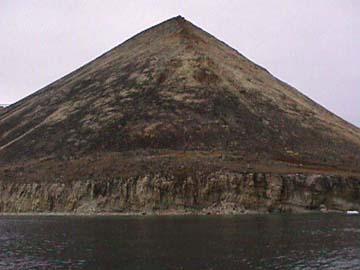
This feature marked the turn into Mac Cormick Fjord.
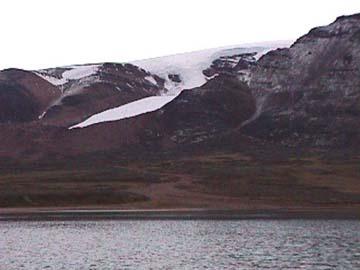
View from study site to the South.
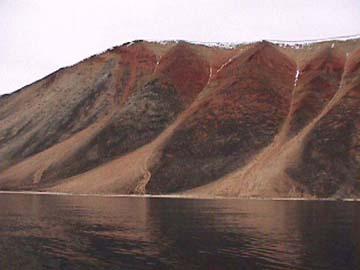
View of the study site from the south.
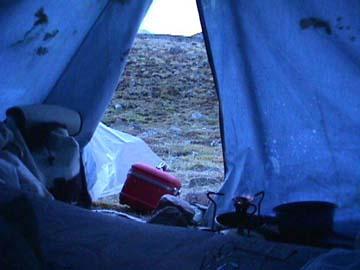
View from inside the tent. Notice the primus stove heat source to the right.
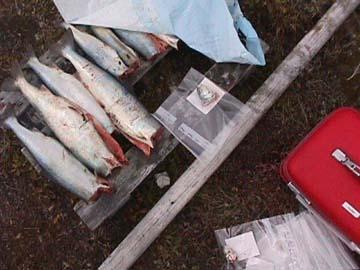
Our catch from the gill net. After I measured them, I cut off their heads, labeled and bagged them. They ranged in size from 15-40cm.

Contact the TEA in the field at
.
If you cannot connect through your browser, copy the
TEA's e-mail address in the "To:" line of
your favorite e-mail package.
|
